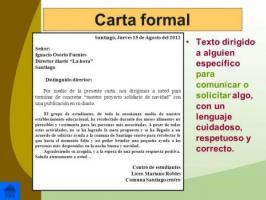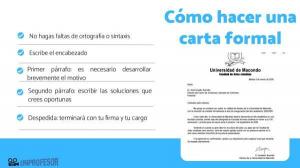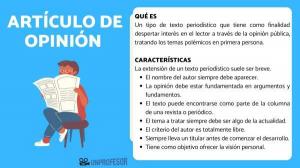Examples of ARGUMENTATIVE texts + characteristics
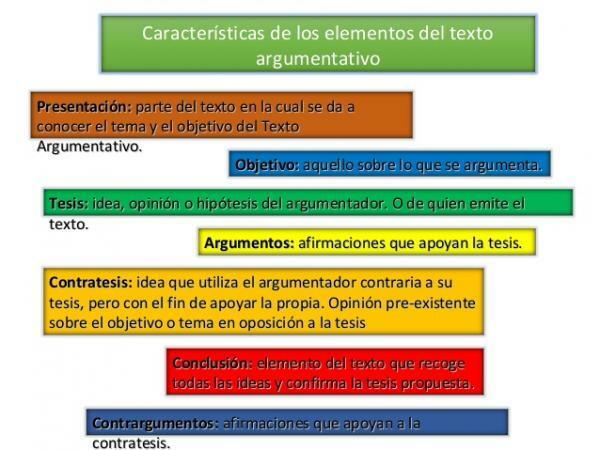
Image: Slideshare
In Spanish there are different types of texts that are used for different purposes when expressing what the author wants. In this lesson from a TEACHER we are going to focus on characteristics and examples of the argumentative text. Knowing them will help you to identify these types of texts and to know how you can develop your own when you need it. We start with this new Spanish language lesson!
Before starting to talk about the characteristics of the argumentative text, we must refer to what argumentation is. Thus, we can define it as the action that consists of provide reasons that demonstrate falsehood or certainty regarding an idea or opinion.
Its purpose is to get the receiver of the message to be convinced of what we are telling them and finally adopt the main idea defended in the text. Therefore, the argumentation seeks to persuade, although it also provides information.
We can see argumentation in different types of text such as: newspaper opinion articles, publicity texts, doctoral theses or humanistic texts, among others.
Parts of an argumentative text
In order to identify or write a argumentative text it is necessary to identify three elements that always appear in all of them. So we can highlight the following:
- Thesis: it is the fundamental idea around which all the reflection of the text revolves. This can appear in different parts of it, but the most common is that it appears at the beginning of it. If this is the case, we would be talking about a deductive thesis. If, on the other hand, it appears at the end of this, it will be an inductive thesis, that is, it is the conclusion of all the arguments that have been given previously.
- Argumentative body: it is where the argumentation as such is collected. In this part of the text we will find the different arguments or reasoning. These arguments can be divided into others such as: arguments from authority, arguments by examples, arguments by analogy, arguments from the majority or minority, arguments from one's own experience.
- Conclution: it is a final statement that is derived from the statement initially raised and the arguments that have appeared in the body of the text. The conclusion is a consequence of the thesis. This can suggest or imply new ideas with the aim of leaving the argument open for a future text.
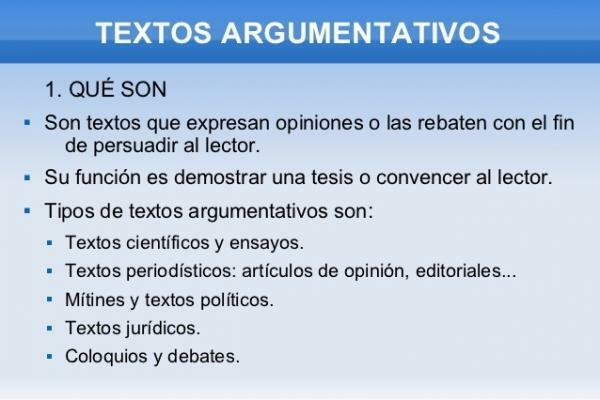
Argumentative texts, as such, have a series of featuresthat apply to argumentative texts and that we are going to list below:
- Language: interrelated terms that belong to the same semantic fields are used. This is because the subject is specific and requires the use of these terms. On the other hand, the use of qualifying adjectives that have an evaluative character is frequent. In this way it is possible to consolidate the thesis raised.
- Precise meanings: Another characteristic of the argumentative text is that they have a precise meaning. Words that have a unique meaning are often used. This seeks to avoid double meaning in the use of words, so that the arguments are as clear as possible.
- Technicalities: use of own language and specific to the subject at hand.
- Use of declarative, exclamatory and interrogative sentences. In this way, the reader can be involved in the text and in its argumentation. On the other hand, your attention is drawn to the main idea and what is being exposed.
- Use of subordinate clauses: thanks to this sentence structure, reasoning can be easily expressed. In other words, a relationship of cause and consequence is established between the different ideas that have been exposed in the text.
- Using replay resources: they are not intended to provide new information, but rather to emphasize the arguments and the main idea of the text, especially if the subject is difficult to understand. On the other hand, these types of elements also work to unite the different parts of the text, that is, with cohesion elements within it.
- Use of textual markers: these help to structure the text by pointing out the paragraphs and joining the ideas and arguments that appear in the body of the text.
Here is an example of an argumentative text in which you will be able to see the characteristics that we have previously listed:
Abandoned elders (Fragment)
Editorial of The country from 03/19/2020
The main objective of the confinement measures dictated to fight the coronavirus is to curb its expansion and thus protect the most vulnerable people, which are the elderly and those who suffer from pathologies previous. It is a great contradiction, therefore, that security measures have not been reinforced precisely in the places where there is the greatest concentration of vulnerable people: the nursing homes. The drip of cases with a high number of infections and deaths known in the last hours indicates that these residences are experiencing a situation of intolerable collapse and abandonment.
Shock measures have so far focused on strengthening the system's response capacity health, but it is urgent to extend them to those residences, where the virus can make greater havoc. The people who live in them and those who care for them are at high risk because they are closed places with a high concentration of people of weak health who share room and spaces common. The templates of these centers are very fair even under normal circumstances, so that the ease of spread, we must add the loss of those workers who have also been infected and who are in quarantine. […]
Now you know the characteristics of argumentative texts. If you want to continue learning about similar topics, do not hesitate to visit our sections of Spanish language On our website.

